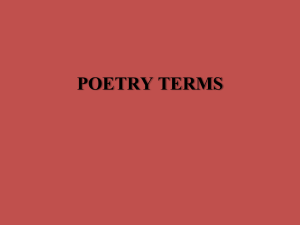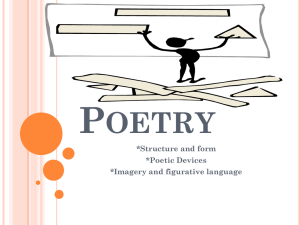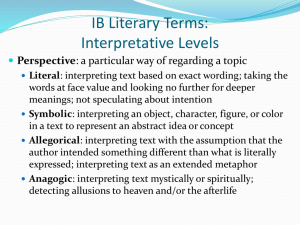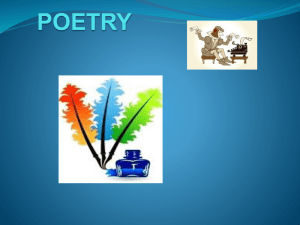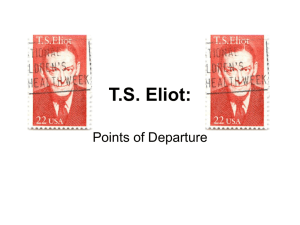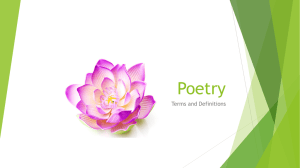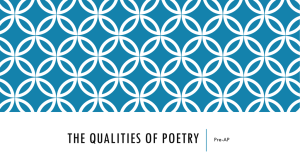File
advertisement
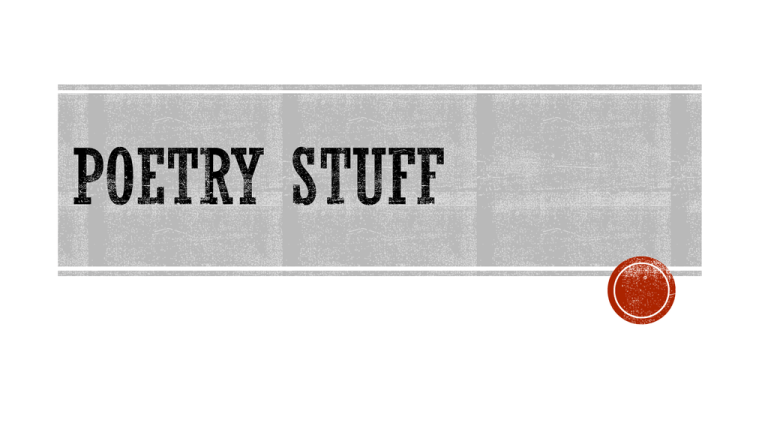
Poetry is a literary form characterized by a strong sense of rhythm and meter and an emphasis on the interaction between sound and sense. The study of the elements of poetry is called prosody. The Human Brain •Divided into 2 parts •Each half has its own function Left Brain: Logic Reality Right Brain: Creativity Emotions To clarify . . . When you are looking at big puffy clouds . . . Your right brain tells you, “Hey! That one looks like a bunny.” While your left brain tells you . . . It’s a cloud, Stupid! SO, WHICH HALF DO YOU USE WHEN STUDYING POETRY? Here are a few hints: Poetry requires creativity Poetry requires emotion Poetry requires an artistic quality Poetry requires logic An “image” is “a word or sequence of words that refers to any sensory experience”(Kennedy and Gioia 741). Figurative language uses figures of speech to convey unique images and create some sort of special effect or impression. A “figure of speech” is an intentional deviation from the ordinary usage of language. A simile is a type of metaphor, a figure in which an explicit comparison is made using the comparative words like or as. (Sometimes, one may use resembles or than as well.) Similes are easy to spot. My love is like a red, red rose. My love was as beautiful as a rose My love resembles a rose. My love is redder than a rose. A metaphor also compares, but a metaphor is a bit more sophisticated than a simile. For one thing, in a metaphor, the words like or as are missing. So readers have to recognize the comparison on their own without those easy words which help us to spot a simile so quickly. The term metaphor has two meanings, a broad, more general meaning and a concise, specific meaning. All figures of speech which use association, comparison, or resemblance can generally be called types of metaphor, or metaphorical. One specific figure of speech which compares two things by saying that one IS the other is called a metaphor. Love is a battlefield. My brother is a prince. Cox Stadium was a slaughterhouse Friday night. Richard was a lion in the fight. Her eyes are dark emeralds. Her teeth are pearls. But avoid Mixed Metaphors (combining two or more incompatible images in a single figure of speech): Management extended an olive branch in an attempt to break some of the ice between the company and the workers. What is implied here about the speaker’s love? Oh, my love has petals and sharp thorns. Oh, I placed my love into a long-stemmed vase And I bandaged my bleeding thumb. And here, what is implied about the city and the subway? The subway coursed through the arteries of the city. This kind of metaphor may run through an entire work. Sometimes a poet will use an extended metaphor throughout a poem rather than simply as one single figure of speech in a poem. A dead metaphor has been so used and overused that it has lost its power to surprise, delight, or effectively compare. A cliché is a dead metaphor, a phrase so often repeated that it no longer has force: He hit the nail on the head. She was cool as a cucumber. Jump out of the frying pan and into the fire. This PowerPoint show is crystal clear. Avoid the use of clichés in your own writing! Another kind of comparison is called personification. Here, animals, elements of nature, and abstract ideas are given human qualities. John Milton calls time “the subtle thief of youth” (599). Homer refers to “the rosy fingers of dawn” (599). Other examples of personification The stars smiled down on us. – An angry wind slashed its way across the island. Oxymoron - two contradictory terms are placed side by side, usually for an effect of intensity: darkness visible (John Milton) burning ice Blinding brightness People often enjoy joking sarcastically by declaring certain pairs of words to be oxymorons: military intelligence Hyperbole (hy per bo lee) is intentional exaggeration or overstating, often for dramatic or humorous effect: Your predicament saddens me so much that I feel a veritable flood of tears coming on. The intentional understatement is used for effect also: “Thank you for this Pulitzer Prize: I am pleased.” Another kind of understatement called Litotes occurs when a negative is used to state a positive: “When I won the Pulitzer Prize, I was not unhappy.” A person or thing which is absent is addressed: “What thoughts I have of you tonight, Walt Whitman” (Ginsberg 599). “Oh sun, I miss you, now that it’s December.” In this figure (m’ tawn ni’mee) one thing is replaced by another thing associated with it: The Crown is amused (“The Crown” is the Queen). The White House is furious (“The White House” is the President). Here, (sin nec duh kee) a part represents the whole: All hands on deck! Lend me your ears. Let’s buy one hundred head of cattle! Referring to some thing famous that shows a comparison. [The mantis shrimp] is Ghengis Khan bathed in sherbet ice cream. a statement that appears to be self-contradictory or silly but may include a latent truth. Your enemy’s friend is your enemy. I am nobody. “What a pity that youth must be wasted on the young.” George Bernard Shaw “I can resist anything but temptation.” Oscar Wilde “All animals are equal, but some are more equal than others.” George Orwell Onomatopoeia – sounds like the word (buzz, pop, sizzle) Pun – play on words (Ask for me tomorrow and you will find me a grave man.) Idiom – only an idiot would take it literally (Raining cats and dogs) Allegory - a story, poem, or picture that can be interpreted to reveal a hidden meaning, typically a moral or political one (Animal Farm) Analogy – comparison to show a deeper meaning (men and ants are alike) Alliteration – Repetition of first letter (Peter Piper picked…) Assonance – Repetition of a vowel sound (rain in Spain) Consonance – Repetition of a consonant sound not at the beginning of the words (I’ll look to like if looking liking move. –this is both alliteration and consonance) “good sound” Refers to language that is smooth and musically pleasant to the ear “Many consider “cellar door” one of the most euphonious phrases in English.” harsh sounds The clash of discordant sounds within a sentence or phrase. A familiar feature of tongue twisters but can also be used to poetic effect. It is language that is discordant and difficult to pronounce. “Player Piano” “never my numb plunker fumbles.” -John Updike In Shakespeare’s Macbeth: “Life’s but a walking shadow, a poor player, That struts and frets his hour upon the stage And then is heard no more. It is a tale Told by an idiot, full of sound and fury, Signifying nothing.” Poetry that follows no rules. Just about anything goes. This does not mean that it uses no devices, it just means that this type of poetry does not follow traditional conventions such as punctuation, capitalization, rhyme scheme, rhythm and meter, etc. Fog by: Carl Sandburg The fog comes on little cat feet. It sits looking over harbor and city on silent haunches and then, moves on. No Rhyme No Rhythm No Meter This is free verse. The repetition of sounds Example: hat, cat, brat, fat, mat, sat My Beard by Shel Silverstein My beard grows to my toes, I never wears no clothes, I wraps my hair Around my bare, And down the road I goes. Give a letter to each new rhyming word and each time in the poem that rhyme is used, it assigned the same letter: The Life Of A Cupcake 1. 2. 3. 4. They put me in the oven to bake. Me a deprived and miserable cake. Feeling the heat I started to bubble. Watching the others I knew I was in trouble. • • • • A A B B 5. 6. 7. 8. They opened the door and I started my life. Frosting me with a silver knife. Decorating me with candy jewels. The rest of my batch looked like fools. • • • • C C D D 9. 10. 11. 12. Lifting me up, she took off my wrapper. Feeling the breeze, I wanted to slap her. Opening her mouth with shiny teeth inside. This was the day this cupcake had died. • • • • E E F F End rhyme = the last word in each line rhymes Internal rhyme = words within a line rhyme Using the same key word or phrase throughout a poem. This should be fairly self-explanatory, but at risk of sounding like a broken record . . . Valued Treasue by Chris R. Carey Time to spend; time to mend. Time will eventually show us the truth. Time to hate; time to wait. Time is a mystery; time is a measure. Time is the essence; time is the key. Time for us is valued treasure. Time will tell us what we will be. Time to spend; time to mend. Time is the enemy; time is the proof. Time to cry . . . Time to die. The repetition of one or more phrases or lines at the end of a stanza. It can also be an entire stanza that is repeated periodically throughout a poem, kind of like a chorus of a song. Phenomenal Woman by Maya Angelou Pretty women wonder where my secret lies. I’m a woman I’m not cute or built to suit a fashion model’s size Phenomenally. But when I start to tell them, Phenomenal woman, They think I’m telling lies. That’s me. I say, It’s in the reach of my arms, The span of my hips, The stride of my step, The curl of my lips. This is repeated throughout the poem. When reading a poem out loud, you may notice a sort of “sing-song” quality to it, just like in nursery rhymes. This is accomplished by the use of rhythm. These identify patterns of stressed and unstressed syllables in a line of poetry. That means one syllable is pronounced stronger, and one syllable is softer. iambic: anapestic: trochaic: dactylic: unstressed stressed Spondee Amphibrach Pyrrhic Amphimacer (the amphibrach and amphimacer are often omitted when scanning poetry.) The Iambic foot. By far the most common foot in the English language. It is the sound of the human heart. “Whose woods these are I think I know…” The trochaic foot. The trochee is the opposite of the iamb. “Double, double, toil and trouble, fire burn and cauldron bubble.” The anapestic foot. The anapest is the galloping foot. Imagine a horse galloping along; hear the sounds of its hooves beating out… “ I will go to the lake in the woods…” The Dactylic foot. The dactylic foot is the rhythm of the waltz: ONE two three, ONE two three, ONE two three “Just for a handful of silver he left us be.” You know that it would be untrue, You know that I would be a liar, Spondee Pyrrhic Spondee and pyrrhic are called feet, even though they contain only one kind of stressed syllable. They are never used as the sole meter of a poem; if they were, it would be like the steady impact of nails being hammered into a board--no pleasure to hear or dance to. Inserted now and then, spondee and pyrrhic can lend emphasis and variety to a meter. Amphibrach Amphimacer The amphibrach and amphimacer are often omitted when scanning poetry. Anacursis: the extra unaccented syllable at the beginning of a line. Catalexis: the unaccented syllable at the end of a line. Enjambment: a run-on line, continuing into the next line without a pause. Metric feet make up lines of poetry. Lines of poetry make up stanzas. Stanzas make up cantos in much longer poems. Couplet = a two line stanza Triplet (Tercet) = a three line stanza Quatrain = a four line stanza Quintet = a five line stanza Sestet (Sextet) = a six line stanza Septet = a seven line stanza Octave = an eight line stanza The length of a line of poetry, based on what type of rhythm is used. The length of a line of poetry is measured in metrical units called “FEET”. Each foot consists of one unit of rhythm. So, if the line is iambic or trochaic, a foot of poetry has 2 syllables. If the line is anapestic or dactylic, a foot of poetry has 3 syllables. (This is where it’s going to start sounding like geometry class, so you leftbrainers are gonna love this!) Each set of syllables is one foot, and each line is measured by how many feet are in it. The length of the line of poetry is then labeled according to how many feet are in it. 1: Monometer 5: Pentameter 2: Dimeter 6: Hexameter 3: Trimeter 7: Heptameter 4: Tetrameter 8: Octameter *there is rarely more than 8 feet* She Walks in Beauty She walks in beauty, like the night Of cloudless climes and starry skies; And all that’s best of dark and bright Meet in her aspect and her eyes: Thus mellowed to that tender light Which Heaven to gaudy day denies. Reading this poem out loud makes the rhythm evident. Which syllables are more pronounced? Which are naturally softer? Count the syllables in each line to determine the meter. Examination of this poem reveals that it would be considered iambic tetrameter. Sonnet, Villanelle, Elegy, Ode, and Sestina Follows a fairly strict form 14 lines, usually iambic Three kinds (Petrarchan, Shakespearean, Spenserian) Originated in Italy—Francesco Petrarch From the Italian word sonnetto = little song Love = original topic of the sonnet Shifted form when adapted by the English Sonnet was very popular during the Renaissance period and had a revival with the 19th century romantic poets. Modern perspective: easily comprehended and balances the narrative with the lyric. Divided into two sections Octave (how many lines?) Sestet (how many lines?) Meter = usually iambic pentameter Rhyme scheme (usually these two) Abbaabba/cdcdcd Abbaabba/cdecde 1. Alone, and lost in thought, the desert glade 2. Measuring I roam with lingering steps and slow; 3. And still a watchful glance around me throw, 4. Anxious to shun the print of human tread: 5. No other means I find, no surer aid 6. From the world's prying eye to hide my woe: 7. So well my wild disordered gestures show, 8. And love-lorn looks, the fire within me bred, 9. That well I think each mountain, wood and plain, 10. And river knows, what I from man conceal, 11. What dreary hues my life's fool chances dim. 12. Yet whatever wild or savage paths I've taken, 13. Wherever I wander, love attends me still, 14. Soft whispering to my soul, and I to him. Theory: originated by Shakespeare? No—adapted. Brought to England in the 16th century by Thomas Wyatt and the Earl of Surrey. three quatrains and the couplet is the defining feature Meter = is usually iambic pentameter = light/heavy emphasis Rhyme scheme abab/cdcd/efef/gg NOTE: Spenserian Sonnet Format: three quatrains and a couplet; rhyme scheme = abab/bcbc/cdcd/ee 1. Shall I compare thee to a summer’s day? 2. Thou art more lovely and more temperate: 3. Rough winds do shake the darling buds of May, 4. And summer’s lease hath all too short a date; 5. Sometimes too hot the eye of heaven shines, 6. And often is his gold complexion dimmed; 7. And every fair from fair sometime declines, 8. By chance or nature’s changing course untrimmed; 9. But thy eternal summer shall not fade, 10. Nor lose possession of that fair thou ow’st; 11. Nor shall death brag thou wand’rest in his shade, 12. When in eternal lines to Time thou grow’st: 13. So long as men can breathe, or eyes can see, 14. So long lives this, and this gives life to thee. Consider: What happens? Break it down--what is being said in each unit? Where are the shifts? THINK FORM! Who is the speaker? Whom is the speaker addressing? Is there a problem and solution? A theme and a comment? A question and an answer? What are they? What imagery is used? What senses does the imagery correspond to? How does the imagery contribute to the poem’s overall meaning/theme? Are any of the recurring images symbolic? If so, what do they mean? Identify as Italian or English. How do you know this? Identify as modern or older. What clues do you have? Think diction, detail, imagery, syntax, and tone Explain what the poem is about, develop a statement of theme, and cite at least one line as evidence. 1. 2. 3. 4. 5. 6. 7. 8. 9. 10. 11. 12. 13. 14. I met a traveler from an antique land Who said: Two vast and trunkless legs of stone Stand in the desert…Near them, on the sand, Half sunk, a shattered visage lies, whose frown, And wrinkled lip, and sneer of cold command, Tell that its sculptor well those passions read Which yet survive, stamped on these lifeless things, The hand that mocked them, and the heart that fed: And on the pedestal these words appear: “My name is Ozymandias, king of kings: Look on my works, ye Mighty, and despair!” Nothing beside remains. Round the decay Of that colossal wreck, boundless and bare The lone and level sands stretch far away. 1. The world is too much with us; late and soon, 2. Getting and spending, we lay waste our powers: 3. Little we see in Nature that is ours; 4. We have given our hearts away, a sordid boon! 5. This sea that bares her bosom to the moon; 6. The winds that will be howling at all hours, 7. And are up-gathered now like sleeping flowers; 8. For this, for everything, we are out of tune; 9. It moves us not.--Great God! I’d rather be 10. A Pagan suckled in a creed outworn; 11. So might I, standing on this pleasant lea, 12. Have glimpses that would make me less forlorn; 13. Have sight of Proteus rising from the sea; 14. Or hear old Triton blow his wreathéd horn. 1. Their ordeal over, now the only trouble 2. Was conveying somehow to a boy of three 3. That for a week or two he’d be seeing double. 4. Surely he wouldn’t recall the surgery 5. Years later, but what about the psychic scars? 6. And so, when the patch came off, they bought the toy 7. He’d wanted most. He held it high. “Two cars!” 8. He cried; and drove himself from joy to joy. 9. Two baby sisters…One was enough of Clare, 10. But who could complain?—considering that another 11. Woman had stepped forward to take care 12. Of the girls, which left him all alone with Mother. 13. Victory! Even when he went to pee, 14. He was seconded in his virility. Definition: a French verse form which utilizes repetition of lines and rhymes. History Originally an Italian rustic song Form today = French poet, Jean Passerat (d. 1602) influenced English writers…Oscar Wilde. Structure: 19 lines Five tercets (which are??) One Quatrain Rhyme Scheme: aba/aba/aba/aba/aba/abaa 1st line of the first stanza is repeated as the last line of the second and fourth stanzas. 3rd line of the first stanza is repeated as the last line of third and fifth stanzas. These two refrain lines are repeated as a couplet in the last two lines of the quatrain. So…song-like in quality, but not in narrative due to its circular nature. Read Dylan Thomas’ poem. Whom does the poem address? What is the speaker saying? Villanelles are some times criticized as elaborate exercises in trivial wordplay. Defend Thomas’s poem against this charge. In other words, how does the form support the meaning of the poem? Do not go gentle into that good night, Old age should burn and rave at close of day; Rage, rage against the dying of the light. Though wise men at their end know dark is right, Because their words had forked no lightning they Do not go gentle into that good night. Good men, the last wave by, crying how bright Their frail deeds might have danced in a green bay, Rage, rage against the dying of the light. Wild men who caught and sang the sun in flight, And learn, too late, they grieved it on its way, Do not go gentle into that good night. Grave men, near death, who see with blinding sight Blind eyes could blaze like meteors and be gay, Rage, rage against the dying of the light. And you, my father, there on the sad height, Curse, bless, me now with your fierce tears, I pray. Do not go gentle into that good night. Rage, rage against the dying of the light. Definition: a reflective poem that laments the loss of something or someone (or loss or death more generally). History Greek & Roman = elegiac meter Dactylic hexameter (stressed, unstressed, unstressed syllables) = “marginal” & nursery rhymes Elizabethan Times = certain love poems 17th Century Shift = focus on loss Change in form No set metrical form (no pattern, cadence, or repetition) Public lament that “sets out the circumstances and character of a loss.” Mourns for the person, lists his/her virtues, and seeks consolation beyond the momentary event = grief is a public one Structure relies on “slowly evolving customs and decorums.” Can have elegiac tone! “American Pie” = the song! Definition: A serious formal poem in which a poet grieves the loss of a dead friend. Poet-mourner figures himself and the individual mourned as shepherds Dead shepherd traditionally given a Greek name Highly conventional Opens with an invocation, followed by a statement of the poet’s grief, and a description of a procession of mourners. Typically also discusses philosophy too (fate) Using “O Captain! My Captain!” complete the following tasks: Identify the type of elegy. How do you know this? Quote and explain three qualities of an elegy that the poem possesses. Analyze the tone of the piece. You cannot say “sad.” Homework: Compare/Contrast Whitman’s Elegy with A.E. Housman’s “To an Athlete Dying Young.” Definition: a relatively long, serious, and usually meditative lyric poem that treats a noble or otherwise elevated subject in a dignified and calm manner. History: Ancient Greece; originally a choral poem intended to be sung at a public event Dramatically changed during the Romantic movement. Structure: Regular/Pindaric (rare, typically characterized by a ceremonious or even exalted tone) Irregular/Cowleyan (no pattern; rhyme scheme and stanza at the poet’s discretion.) Horatian (equal length stanzas having the same rhyme and meter.) Trifold Stanzaic Strophe = sung while the chorus danced in one direction Antistrophe = sung while the chorus danced in the opposite direction Epode = sung while standing still Meter = strophe and antistrophe have the same meter “rule of thumb”—starts with an “O” Both the Ode and Elegy seek to elevate a subject. How are they different? What components of the structure of each style of poetry helps to elevate the subjects? Lyrical – Musical quality Ballad – Lyrical poem that tells a story Epic – Long poem that is a story Epitaph – poem for a tombstone

